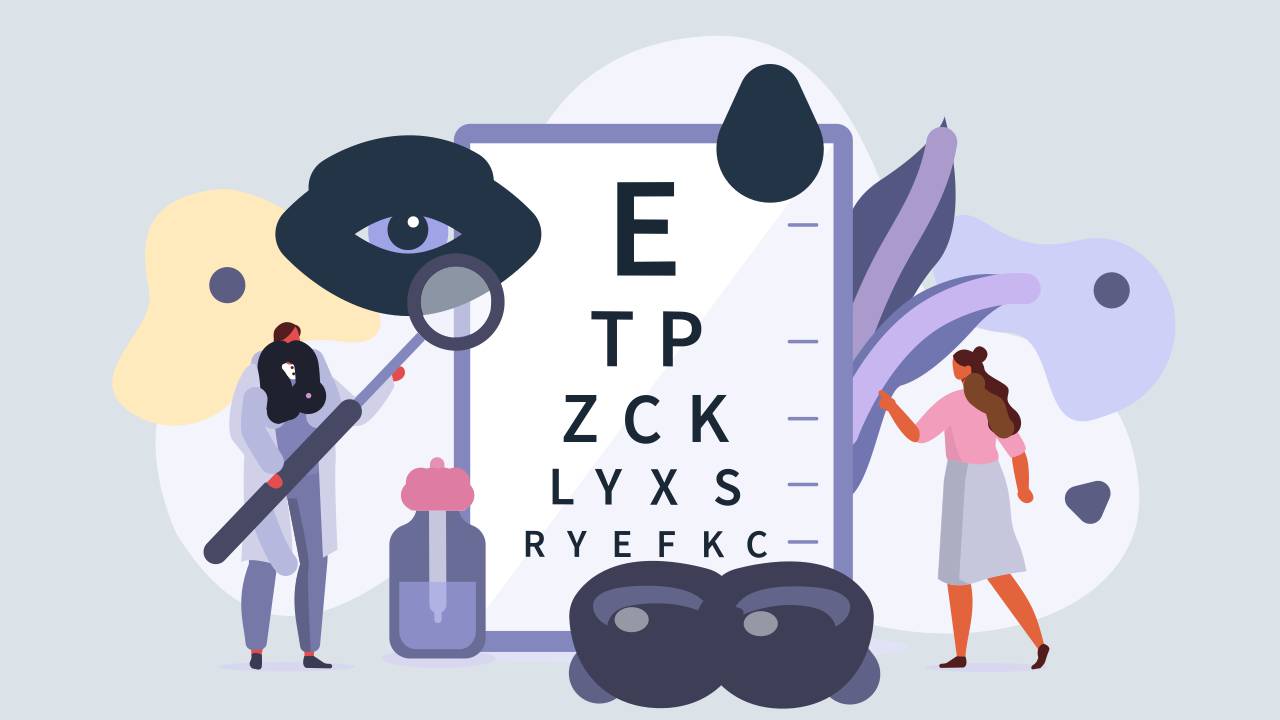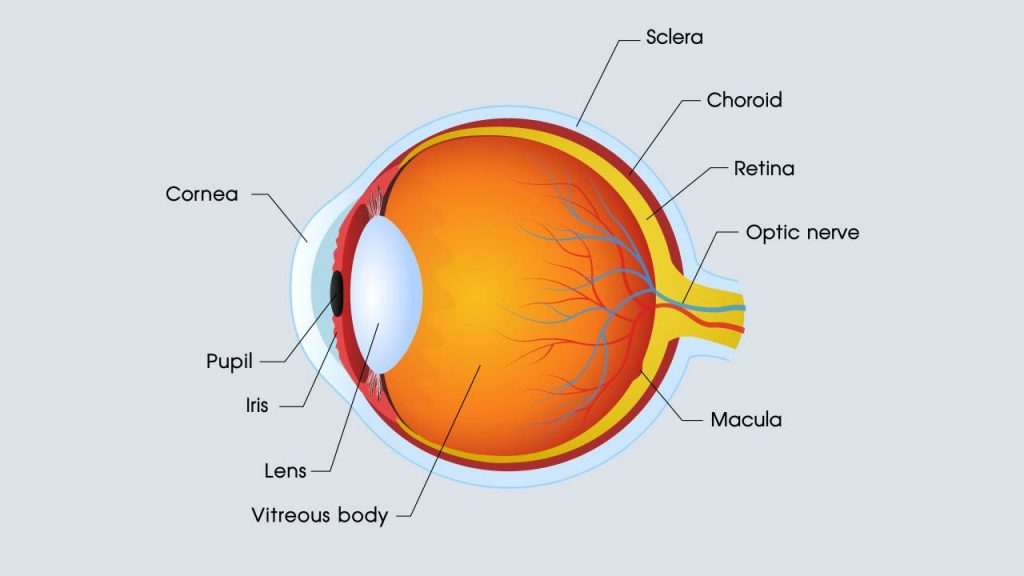
Eye Health: Tips for Maintaining Good Vision

The eye is one of the most incredible organs of the body. It is often referred to as the biological camera because of its ability to capture light and convert it into perceivable images. This organ allows you to see the world around, and should be taken well care of.
What is the eye?
The eye is the sensory organ that enables you to capture light from your surroundings. This captured light relays a series of signals to the brain, which processes the information and allows you to see an object.

Eye anatomy
The eye is shaped like an asymmetric globe and is about one inch in diameter.
1. The eye has three layers:
Sclera: This is the outer white portion of the eye. The front part of the sclera is transparent and is called the cornea
Choroid: The middle layer of the eye is rich in blood vessels. It lies between the sclera and retina
Retina: The innermost layer of the eye, which contains sensory cells, is called the retina. It captures the light information and passes it to the brain through the optic nerve
2. Cornea: The clear dome in front of the iris, which is known as the cornea, helps focus the light entering the eye
3. Iris: Behind the cornea is the iris. It is the colored portion of the eye. The iris controls the amount of light entering the eye
4. Pupil: The opening in the iris is called the pupil. It is the aperture of the eye. Constriction and dilation of the pupil regulates the aperture and the amount of light entering the eye
5. Lens: Situated behind the iris, the lens helps focus light on the retina. Most of the light is focused on the fovea inside the macular region of the retina. Changes in the shape of the lens can cause blurred vision
6. Aqueous humor: It is a water-like substance present in the lens and cornea. It nourishes the lens and maintains pressure
7. Vitreous humor: It is a jelly-like substance that fills the eyeball and helps in shaping the eyeball and the transmission of light.
8. Optic nerve: It transfers signals from the light via the sensory cells to the brain
9. Macula: An important part of the retina, it is responsible in our central vision, most of our colored vision and also helps provide sharp, clear details of what we see
How do you see an image?
- Light is focused on the lens with the help of the cornea.
- The pupil controls the amount of light that is being focused.
- The lens then focuses the light on the retina, where the information is then relayed to the brain through the optic nerve.
All these parts enable you to see the picture. Now that you see how the whole system works, you can start caring for your eyes better and learn how to protect them.
Eye care
1. Eat healthy
Eat a healthy balanced diet, especially foods rich in omega-3 fatty acids, which prevent degeneration of the macula (the central portion of the retina). Your meals should also include carotenoids that act as light filters, zinc, which is essential for transport of vitamin A, and vitamins like C and E, which act as antioxidants and prevent damage from the free radicals.
The following food helps improve eye health.
| Nutrient | Food |
| Omega-3 fatty acids | Salmon and tuna |
| Vitamins C and E | Green leafy vegetables like spinach, kale, and Brussels sprouts |
| Lutein | Green leafy vegetables like spinach, kale, squash |
| Vitamin A (beta-carotene) | Carrots, sweet potato, and mangoes |
| Zinc | Beef, pork, oysters, chickpeas, and lentils |
2. Maintain healthy weight
Being overweight or obese increases your risk of type-2 diabetes, which is responsible for diabetic retinopathy and glaucoma.
3. Exercise
Exercise helps you in keeping your weight in check and controls cholesterol, high blood pressure, and diabetes. If they go unchecked, it can affect your eye and cause vision impairment.
4. Wear protective eyewear
a. Wear sunglasses that block 99% to 100% ultraviolet (UV) rays. Direct exposure to the sun’s rays can damage your eyes and make them susceptible to cataracts and age-related macular degeneration, which happens because of the wearing down of the macula.
b. Wraparound glasses provide extra protection from the sides. These are of special benefit in extremely cold regions, where they provide additional benefit of protecting the skin around the eyes from frostbite.
c. If you wear contact lenses, opt for ones that provide UV protection.
5. Protect your eyes from infections and injuries
a. While playing sports like ice hockey, conducting chemical experiments at labs, or doing repair work at home, wear protective eye goggles to prevent any sort of eye injury.
b. Wash your eyes with copious amounts of cold water if any foreign body enters. Do not rub or try to remove the foreign object with your fingers or cloth.
c. Never share your eye makeup, brushes, or eye pencils with anyone.
d. Avoid using common face towels and hand towels in gyms, restaurants, or other outdoor places.
6. Quit smoking
Smoking increases the risk of developing cataracts, macular degeneration, and optic nerve damage.
7. Protect your eyes from screen
Staring at the mobile phone or computer for long can cause eyestrain, blurry vision, dry eyes, headaches, difficulty focusing on distant objects, and pain in the neck and shoulders.
To protect your eyes from computer screens, do the following:
a. Keep the computer screen about 20 to 24 inches away from the eye
b. Wear glasses with the correct prescription from your eye doctor
c. Set the screen in such a way that the middle of the screen is around 20 degrees below your eye level. Limit screen time. Ideally, adults should limit screen time to two hours per day. But in case it is not possible due to occupational requirements, make sure to look away from the screen after every 20 minutes and concentrate on some distant object for a minimum of 20 seconds. This will rest your eye muscles and prevent damage due to muscle fatigue
d. Use a good source of lighting to avoid eye strain
e. Use an anti glare screen and glasses and take a break after every two hours
8. Visit your eye doctor
a. Eye check-ups are mandatory for both children and adults. Schedule your visits at regular intervals
b. However, the frequency of your eye check-ups depends on your overall health and family history. Discuss with the optometrist or ophthalmologist your family and medical history, so you know if you are at greater risk of developing an eye disease
c. An eye check-up usually involves peripheral vision testing, color vision testing, vision acuity, pressure inside the eye to detect glaucoma, dilation to view retina, macula, and refraction test to check for refractive errors
9. Wash your hands
Before touching your eyes, wash your hands. This will prevent infections like conjunctivitis (pink eye). If you wear contact lenses, make sure you wash hands with a mild soap and dry with a lint-free towel before touching your lenses. To clean your lenses, use contact lens solutions.
10. Soothe your eyes
To sooth your eyes, you can use:
a. Humidifier: Use a humidifier at home to avoid dryness
b. Cold compress: Use cucumbers or dampened green tea bags to reduce puffiness and dark circles around the eyes. It also soothes and relaxes the area around the eyes
c. Eye roller: Use eye rollers or gently massage your eyes to increase the blood supply
Your eyes are your windows to the world. They are extremely precious. Take good care of them and protect them from injuries.
References
1. A Picture of the Eye. WebMD. https://www.webmd.com/eye-health/picture-of-the-eyes (accessed Mar 22, 2021).
2. Omega-3 for your eyes. Harvard Health Publishing. https://www.health.harvard.edu/heart-health/omega-3-for-your-eyes#:~:text=%22DHA is the primary structure of blindness in older people.%22 (accessed Mar 22, 2021).
3. How to Keep Your Eyes Healthy. WebMD. https://www.webmd.com/eye-health/good-eyesight (accessed Mar 22, 2021).
4. 10 Foods That Are Good for Your Eyes. WebMD. https://www.webmd.com/eye-health/ss/slideshow-eyes-sight-foods#:~:text=Dark%2C Leafy Greens,diseases%2C including AMD and cataracts (accessed Mar 22, 2021).
5. Eye Care. NIH- Medline Plus. https://medlineplus.gov/eyecare.html (accessed Mar 22, 2021).
6. Healthy Eyes. Bausch. https://www.bausch.com/vision-and-age/20s-and-30s-eyes/healthy-eyes (accessed Mar 22, 2021).
7. Keep Your Eyes Healthy. NIH. https://www.nei.nih.gov/learn-about-eye-health/healthy-vision/keep-your-eyes-healthy (accessed Mar 22, 2021).
8. Morris SY. Can Supplements Improve Eye Health and Vision? Healthline. https://www.healthline.com/health/eye-health/eye-health-supplements (accessed Mar 22, 2021).
9. Take Care of Your Eyes Now For Good Vision In Later Life. American Academy of Ophthalmology. https://www.aao.org/eye-health/tips-prevention/healthy-lifestyle-now-good-vision-later (accessed Mar 22, 2021).
10. How Much Screen Time Is Too Much? Scripps. 2019; published online Feb 22. https://www.scripps.org/news_items/6626-how-much-screen-time-is-too-much (accessed Mar 23, 2021).














